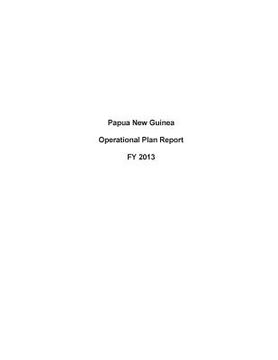Reseña del libro "Papua New Guinea Operational Plan Report FY 2013 (en Inglés)"
Papua New Guinea (PNG) has an estimated population of 7 million people, which accounts for well over half of the 10 million total persons living in the 22 Pacific Island states. PNG is a diverse country with 85% living in rural areas, and more than 700 languages (NSO, 2011 and World Bank, 2012). While PNG has enjoyed recent economic progress and has bright prospects for future revenue growth, growth has not been inclusive or broad based. The country still ranks a very low 153 out of 187 on the Human Development Index. According to the World Health Organization, PNG has the lowest health status in the Pacific region. Among the leading causes of mortality are HIV/AIDS, tuberculosis (TB), pneumonia, and malaria. TB and pneumonia have high prevalence rates and are often associated with HIV infection. National TB/HIV co-infection rates are very high at 9%, and TB/HIV co-infection even higher in Port Moresby at 23%. PNG has the highest prevalence of HIV/AIDS among the Pacific Island Nations (UNAIDS, 2011). Ninety-five percent of HIV cases reported in the Pacific between 1987 and 2008 were Papua New Guineans (Coghlan et al, 2011). The Government of PNG (GoPNG) estimates that there are 34,000 people living with HIV in the country (31,000 adults and 3,100 children) (NACS/NDOH/UNAIDS, 2011). The first HIV case was reported in 1987 and reported cases have increased steadily since that time. HIV transmission is primarily heterosexual; important contextual factors include high rates of sexually transmitted infections (STI) with limited availability of effective treatment, early sexual debut, multiple and concurrent sexual partners including polygamy, sexual violence and rape, transactional sex, low and inconsistent condom use, increased mobility especially of men for work, and use of marijuana and alcohol. Illicit drug injection has been documented but is still thought to be very rare in PNG (NRI, 2010). While much is still unknown about the current and future status of the HIV epidemic in PNG, there is sufficient data to conclude that the epidemic has extended beyond urban and peri-urban areas to rural areas. Though HIV has been reported in all 22 provinces, the epidemic appears to show a geographical focus in the five Highlands provinces, home to 40% of nation's population but reporting 60% of the total number of HIV cases in 2010 (NDOH, 2011). Further, it is believed that the epidemic is concentrated in locations with a convergence of risk behaviors such as urban centers, along key transport routes (e.g. Highlands Highway), mining areas such as Liquified Natural Gas (LNG) sites, and other rural economic enclaves (IRG, 2011). While national HIV prevalence for adults is estimated at nearly one percent, HIV infection rates are much higher among most-at-risk populations (MARPs) compared to the general population. A 2010 integrated bio-behavioral survey conducted in the capital city of Port Moresby showed that female sex workers (FSWs) had a prevalence of 19%. For males who have sex with males (MSM) HIV prevalence was 14.1% and for transgender women HIV prevalence was 23.7% (IMR, 2010).

